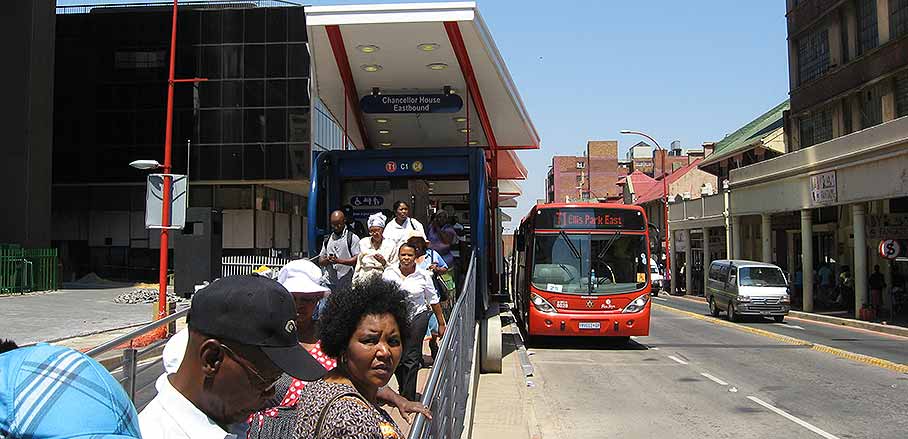The challenge of changing travel behaviours
An interview with Roger Behrens
Urban travel requirements are constantly changing, and so are the challenges that cities face in keeping their inhabitants mobile. In an interview with URBANET, University of Cape Town associate professor Roger Behrens talks about the importance of accessibility, the challenges for local governments and the changing travel dynamics in South Africa.
Mr Behrens, what would you say is the most significant change in urban travel behaviour in the last 50 years?
In the ‘global north’, the most significant change is alarming growth in dependency on private transport, and associated decline in public transport and non-motorised mode use. There are of course outliers and exemplars of more sustainable transport, but the general pattern has been in this direction. In the ‘global south’, some cities have seen rapid growth in car use, threatening to follow the same problematic path of car dependent cities in the ‘global north’. Others have seen a rapid increase in informal public and for-hire modes of transport as city populations have grown, with associated declines in walking as motorised transport is needed to cover the greater distances resulting from expanding cities.
What is specifically happening in South Africa? How are changing travel behaviours answered with new solutions?
South African cities are fairly dualistic, reflecting the high prevalent level of income inequality. One part of the population are heavy users of private transport. The other are captive to public transport modes. Transport policy in the post-apartheid era has placed priority on public transport modes. In practice, this has been difficult to achieve. Rail services have been in a state of decline, and unscheduled paratransit has gained market share from rail and formal bus companies. Initiatives have been put in place in the last decade to modernise the country’s rail rolling stock, and to introduce Bus Rapid Transit corridors. There has been some choice passenger mode switching to the improved BRT services in cities like Cape Town, but the most noticeable aggregate change has been from scheduled large bus and rail to unscheduled minibus-taxi. Car use has also growth as the middle class has grown in the larger metropolitan areas.
How is changing travel behaviour in South Africa linked to the work/private lives of people?
Aggregate travel behaviour change has accompanied changes in economic status. As households earn more they shift to car ownership and use. Conversely, as unemployment grows in our stagnating economy, so incomes are derived from informal sector activities, and this introduces new complex patterns of travel behaviour in time and space.
What can be done for local governments to build neighbourhoods (with infrastructure etc) and not just houses?
Breaking down institutional silos will be important. A recurring policy failure in the past two decades has been the mismatch between housing subsidies geared towards the cheapest product on the least valuable peripheral land, and the ongoing public transport subsidies required to bring these households into the city. We need integrated planning processes that enable local government officials and decision-makers to make more rational decisions that result in more sustainable long term solutions. Appropriate forms of ‘transit-oriented development’ may hold particular promise in South African cities, as a means of addressing our city inefficiencies.
What can local governments do to raise awareness for the fact that there needs to be a change in travel behaviour to make it more sustainable?
Travel demand management strategies are needed. There is great potential in appropriate forms of travel planning amongst corporations, schools and households, as a means of raising awareness and breaking car use habits. Local governments need to appoint travel planners to their staff.
International experience suggests that voluntary TDM measures work best at a site level. While effective on a site-by-site basis, the effectiveness of voluntary TDM strategies and TDM awareness programmes on a city-wide level tends to be limited however, seldom resulting in more than a couple of percentage points change in mode share. If we accept the notion of ‘induced traffic’, whereby new road space reduces the cost of car travel and releases latent demand, then we need to accept that voluntary TDM measures might have the same effect. So ideally reallocation of road space to public and non-motorised users should form part of a ‘locking in’ of the benefits of TDM measures. This ensures that generalised costs for single occupancy car travel remain constant, and that TDM impacts that reduce congestion do not simply induce further car traffic. An alternative to road space reallocation in maintaining constant generalised costs for single occupant car travel is congestion pricing, but this is politically difficult to implement.
It is equitable and justifiable to reallocate proportionate shares of road space, in the form of footways, cycleways and dedicated bus lanes, for exclusive use by pedestrians, cyclists and public transport users. Evidence of ‘suppressed traffic’ suggests that, provided policy commitments to improving the quality and safety of public transport services are followed through, this would not lead to the general traffic chaos many might expect.
How does accessibility change the dynamic of a city?
When accessibility is increased, it will help break down some of the conditions that maintain high levels of inequality and structural poverty.
Changes in accessibility also play a large role in determining land values and associated land use distributions. So policies to improve accessibility need to be targeted spatially. Access to the benefits of agglomeration need to be increased, which implies increasing access to places of work, education, commerce, recreation and culture. A careful balance needs to be struck between this objective and stimulating sprawling city growth. Transit-oriented development is a useful way of thinking about this problem.
- The challenge of changing travel behaviours - 20. December 2016
